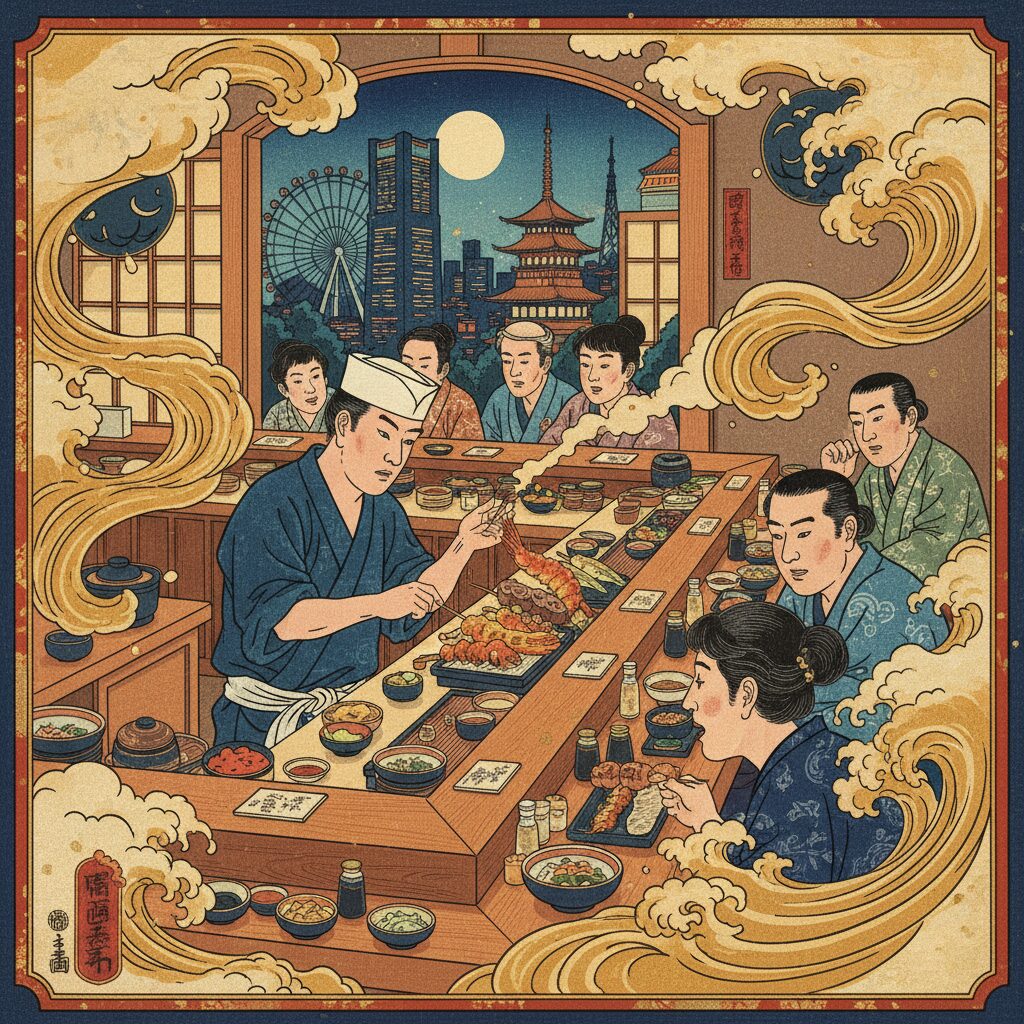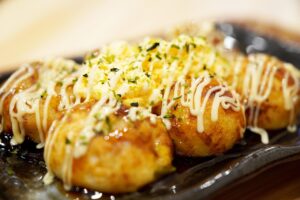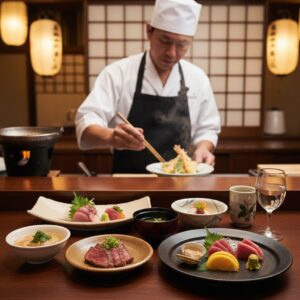Osaka. The name itself conjures a vibrant symphony of senses: the sizzle of takoyaki on a hot griddle, the boisterous laughter spilling from an izakaya, the neon-drenched chaos of Dotonbori. This is the city known as Japan’s kitchen, a place where food is not merely sustenance, but the very soul of the culture—bold, unpretentious, and served with a hearty dose of warmth. Central to this culinary identity is kushikatsu, the beloved local specialty of skewered, breaded, and deep-fried morsels of everything imaginable. Traditionally, it’s the food of the people, enjoyed standing up in the bustling, nostalgic neighborhood of Shinsekai, with a communal pot of dipping sauce and one golden rule: no double-dipping. It’s delicious, it’s democratic, it’s quintessentially Osaka.
But peel back that wonderfully familiar layer, and you’ll discover another world. Journey north from the raucous energy of Minami to the polished, soaring heart of the city: Umeda. Here, amidst the gleaming glass towers, luxury department stores, and sophisticated art galleries, Osaka’s culinary scene reveals a different facet of its personality. In the quiet, elegant restaurants hidden within this modern metropolis, kushikatsu has undergone a breathtaking transformation. It sheds its street-food skin and emerges as a refined, creative, and utterly captivating gastronomic experience. This is not the kushikatsu of crowded stalls and shared sauce pots. This is culinary artistry, where each skewer is a carefully composed masterpiece, designed to be savored slowly, thoughtfully, in an atmosphere of serene exclusivity. It’s an experience perfectly suited for an intimate dinner date, a crucial business meal, or for any traveler seeking to understand the profound depth and versatility of Japanese cuisine. This is your guide to discovering that elevated world, a journey into the heart of Umeda’s gourmet kushikatsu scene, where tradition is not replaced, but refined into a new form of edible art.
For a different but equally sophisticated dining experience in Umeda, consider the exquisite fine dining Wagyu available at restaurants near the Umeda Sky Building.
The Umeda Metamorphosis: A District’s Ascent to Culinary Sophistication

To grasp the evolution of kushikatsu, you must first understand the essence of its modern stage, Umeda. This district serves as Osaka’s northern gateway, a dizzyingly complex transportation hub that pulses with the constant flow of millions. Yet, to reduce it to a mere commuter zone would be a significant underestimate. Umeda represents the city’s sleek, contemporary visage, standing in stark and elegant contrast to the gritty, nostalgic charm of the south. While Namba and Shinsaibashi explode with color and noise, Umeda offers a symphony of steel, glass, and carefully curated light. It is a vertical city, where life unfolds not only along streets but also high above, floor after floor.
The atmosphere here exudes ambition and refinement. Stroll through the vast, cathedral-like atrium of Grand Front Osaka, and you’ll find yourself surrounded by global flagship stores, cutting-edge technology showrooms, and sophisticated cafes filled with elegantly dressed patrons. Cross the street to the iconic Hankyu Umeda Main Store, a palace of consumption where window displays are theatrical spectacles and the basement food hall, or depachika, is a dazzling realm of gourmet delights. This environment caters to a discerning clientele: business executives closing deals, couples celebrating milestones, and international visitors with a taste for luxury. The air feels distinct—less the boisterous kuidaore (eat ’til you drop) spirit of Dotonbori and more a quiet, assured appreciation of quality.
This very setting provided the perfect incubator for a new style of dining. The demand shifted from fast, cheap, and filling to unique, memorable, and exquisitely crafted experiences. Chefs, sensing this opportunity, began to reimagine Osaka’s classic dishes. They preserved the soul of kushikatsu—its comforting crispiness and celebration of individual ingredients—and elevated it by incorporating techniques and philosophies from haute cuisine, kaiseki, and even the meticulous world of Edomae sushi. They established their sanctuaries not on crowded street corners, but in discreet upper floors of commercial buildings or along quiet, lantern-lit alleys, fostering an air of discovery and exclusivity. Dining in Umeda, therefore, becomes an intentional act, a destination itself, a conscious choice to engage with the city’s modern culinary identity.
The Anatomy of an Art Form: Deconstructing Gourmet Kushikatsu
What truly distinguishes the kushikatsu of Umeda from its humble beginnings? The difference goes beyond price or décor; it resides in a meticulous dedication to detail that infuses every step of the process, from selecting ingredients to the final, delicate presentation of the skewer to the diner. It is a thorough deconstruction and reinvention of a classic dish, transforming it into something fresh and profound.
The Foundation: Ingredients of Impeccable Quality
At a traditional kushikatsu stand, the menu features familiar comforts: pork loin (tonkatsu), onion, quail eggs, lotus root. In Umeda’s finest establishments, however, the menu becomes a dynamic poem shaped by the seasons. The chef serves as a curator, sourcing the absolute best available from markets across Japan each morning. In spring, you might encounter tender bamboo shoots, delicate white asparagus from Hokkaido, or a skewer of firefly squid, its oceanic richness wrapped in a whisper-thin crust. Summer brings sweet corn from a particular farm famed for its remarkable sugar content, plump saltwater eel (anago), and perhaps a surprising skewer of ripe fig wrapped in prosciutto. Autumn is announced by earthy matsutake mushrooms, creamy ginkgo nuts, and rich, fatty saury fish. Winter offers the deep umami of Kasumi crab legs, plump oysters from Hiroshima, and hearty root vegetables sweetened by the cold earth.
More than seasonality, there is an obsession with origin and luxury. The beef is not just beef; it’s A5-grade Wagyu, so richly marbled it melts inside its crispy shell. The prawns are sweet, succulent kuruma ebi, often served with the head fried separately to a cracker-like crispness. Unexpected, inventive pairings appear as delightful surprises: a morsel of creamy uni (sea urchin) atop a fried shiso leaf, a cube of foie gras paired with winter melon, or a sphere of Camembert cheese that bursts open, its molten core drizzled with truffle-honey. Each skewer is a singular, focused celebration of one perfect ingredient, its natural flavor enhanced, never masked, by frying.
The Execution: Batter, Panko, and Oil
The allure of upscale kushikatsu lies in its astonishing lightness. You can enjoy a dozen or more skewers without ever feeling the heavy, greasy sensation often linked to deep-fried food. This is achieved through three perfected components. First, the batter. Each chef guards their own secret recipe, but it is always thin and ethereal, serving merely as a vehicle to hold the breading to the ingredient. It often includes egg, flour, and sometimes a bit of yam or other starches for extra delicacy.
Next, and perhaps most crucially, comes the panko, the Japanese breadcrumbs. Forget the coarse, dense crumbs found in supermarket bags. High-end chefs use custom-made panko, ground to a precise fineness. Some opt for fresh, soft panko to create a fluffier texture, while others favor drier, finer crumbs for a needle-like crispness. The coating process is an art form; the ingredient is just lightly covered, ensuring the final crust is fragile and lacy, not a heavy armor. Finally, the oil. It is a pristine, high-quality vegetable oil, often a custom blend, maintained at a precise temperature in a gleaming copper pot. The oil is continuously filtered and changed with a frequency unimaginable in casual eateries. This guarantees each item tastes purely of itself, without residual flavors from previous batches. The sound of the skewer slipping into the hot oil is not a harsh sizzle but a gentle, promising whisper.
The Accompaniments: A Palette of Flavors
The communal sauce pot has vanished. In its place, the diner receives a personalized, curated array of condiments. Here, the chef’s creativity truly shines. You may find a small bowl of a complex, house-made dipping sauce, perhaps a lighter, more refined take on the classic Worcestershire-based sauce, enriched with fruit purées and dashi. Yet the real pleasure lies in the salts and other dips. A beautiful ceramic dish might present several small piles: vibrant green matcha salt perfectly paired with white fish, fragrant yuzu salt for vegetables, smoky seaweed salt, and perhaps even a spicy curry salt. Alongside these might be a dollop of Japanese mustard (karashi), a tangy wedge of lemon or sudachi, and a bowl of ponzu sauce with grated daikon. The chef or server guides you, suggesting the ideal accompaniment for each skewer as it arrives: “For the scallop, please try just a hint of lemon and the seaweed salt.” This elevates dining from simple dipping to an interactive, engaging exploration of flavor.
The Omakase Journey: A Chef-Led Symphony on Skewers

In the world of upscale kushikatsu, the most common and rewarding way to dine is omakase, meaning “I’ll leave it up to you.” This entrusts your entire meal to the chef, who creates a unique, flowing tasting menu based on the day’s finest ingredients and their own creative inspiration. It is far more than just a meal; it is a performance, a conversation between chef and diner, with you in a front-row seat.
The experience usually takes place at a smooth, polished wooden counter, often made from a single piece of hinoki cypress that emits a subtle, soothing aroma. From this spot, you can watch the chef’s every move: the swift, precise skewering of ingredients, the delicate dip into batter, the gentle dusting of panko, and the impeccable timing in the hot oil. There is an economy of motion, a focused grace that captivates viewers. It embodies the shokunin spirit—the relentless pursuit of perfection in one’s craft.
The meal unfolds as a carefully paced crescendo. It begins with lighter items to awaken the palate—perhaps a delicate slice of kisu (whiting) or a crisp, sweet asparagus spear. The chef presents it, announcing the ingredient and its suggested accompaniment. Between fried courses, small palate cleansers appear to break the richness and prepare you for what follows. This might be a bowl of crisp cabbage leaves and cucumber sticks served with a savory miso dip, a tiny cup of clear, restorative broth, or a small seasonal appetizer. As the meal progresses, the flavors deepen and grow more complex. You might be served a skewer of rich duck breast with leek, followed by a succulent shiitake mushroom stuffed with minced shrimp, and culminating in a perfectly fried piece of Wagyu beef. The pacing is deliberate, allowing you time to savor each bite, discuss it with your companion, and anticipate the next creation. There is no fixed menu or set number of courses. The chef continues to offer new skewers one by one until you indicate you are satisfied by saying “stop” or “gochisousama deshita” (thank you for the meal). The bill is then calculated based on the number of skewers you have enjoyed. This is an important etiquette point for first-time visitors; since the experience is tailored to your appetite, it’s essential to communicate when you are full.
The Stage is Set: The Intimate Ambiance of an Umeda Kushikatsu Counter
The physical environment of these restaurants is as meticulously curated as the cuisine itself. The aim is to craft a tranquil, intimate refuge that contrasts sharply with the hectic energy of the city beyond the door. These spaces are not large, cavernous dining halls. Most accommodate only a small number of guests, typically ten to twelve seated at a single L-shaped counter, creating a feeling of exclusivity and shared experience. Lighting plays a crucial role, always warm, soft, and carefully directed to highlight the chef’s hands and the exquisite dishes on your plate, while bathing the rest of the room in a gentle, low-lit ambiance.
The design style embodies minimalist Japanese elegance. Natural materials are preferred: the previously mentioned hinoki or oak counter, walls finished with textured plaster or dark wood, and polished stone floors. Clutter is notably absent. The only adornments might be a solitary, striking flower arrangement (ikebana) in an alcove or a piece of calligraphy mounted on the wall. The emphasis remains solely on the food and the craft. Sounds are muted—the soft hum of ventilation, the subtle clink of glasses, the quiet murmur of respectful conversation, and the gentle, rhythmic noises from the kitchen. This serene setting enables your senses to fully engage with the meal, detecting the faint aroma of frying oil, the delicate crunch of panko, and the intricate flavors of each component.
This experience is woven together by the invisible thread of omotenashi, the Japanese ideal of wholehearted hospitality. The service is flawless—attentive yet unobtrusive. Your tea or water glass is refilled before you even realize it’s empty. A fresh napkin is offered at precisely the right moment. The staff moves with quiet elegance, anticipating your needs before you are even conscious of them yourself. This seamless, thoughtful service allows you to relax fully and immerse yourself in the culinary journey, making the evening feel genuinely special and cared for.
Practical Wisdom for a Perfect Evening in Umeda

Navigating the world of upscale dining in an unfamiliar city can feel overwhelming, but with a few essential tips, you can enjoy a seamless and unforgettable experience at one of Umeda’s kushikatsu temples.
The Art of the Reservation
First and foremost: reservations are not merely recommended; they are almost always necessary. These intimate, exclusive restaurants tend to be fully booked weeks or even months ahead, especially on weekend evenings. Walking in without a reservation usually leads to disappointment. The best way to secure a table is to ask your hotel concierge to make the booking for you. They can handle language barriers and often know which places have openings. Alternatively, some establishments now offer online reservations through platforms like TableCheck or Omakase, both accessible in English. If you speak Japanese, calling directly is also an option. Plan ahead to avoid frustration and ensure your spot.
Finding Your Destination
Unlike street-food stalls, Umeda’s gourmet kushikatsu restaurants are understated. They won’t be advertised with large flashing signs or street promoters. Instead, they are hidden gems tucked away in the dining floors of upscale department stores such as Hankyu or Daimaru, nestled within restaurant arcades in buildings like the Umeda Hankyu Building, or located on quiet side streets. Their entrances might feature a simple wooden door and a small, elegant noren curtain with the restaurant’s name written in Japanese. Researching in advance, having the exact address and building name on hand, and using a map app will help you find these tranquil dining spots.
Dress the Part
Though strict dress codes are rare, smart casual attire is the safest choice. You are entering a refined and elegant setting, so dressing appropriately shows respect for the chef, the venue, and fellow diners. For men, this means trousers or smart chinos paired with a collared shirt or a nice sweater. For women, options like dresses, skirts with blouses, or stylish trousers are suitable. Avoid shorts, t-shirts with large logos, flip-flops, or overly casual sportswear. Dressing slightly more polished will help you feel comfortable and fitting for the occasion.
Understanding the Investment
This is a premium dining experience, reflected in the price, which accounts for the quality of ingredients, the chef’s expertise, and impeccable service. A full omakase dinner at a top kushikatsu restaurant in Umeda will generally cost between ¥10,000 and ¥25,000 per person, excluding drinks. It’s wise to keep this budget in mind to avoid surprises. Think of it as an investment in a unique cultural and culinary experience—a chance to savor one of Japan’s most beloved dishes elevated to its finest form.
The Perfect Pairing: Beverages to Elevate Your Meal
The careful curation of the experience extends to the drink menu. The right beverage can cut through the richness of fried food, refresh the palate, and highlight the subtle flavors of the ingredients, elevating a great meal into an exceptional one.
Many of Umeda’s refined kushikatsu restaurants surprisingly offer extensive wine lists, often curated by knowledgeable sommeliers. Champagne or a crisp sparkling wine remains a classic and brilliant choice. The effervescence and acidity serve as the perfect counterbalance to the fried coating, revitalizing your palate with every sip. A dry, mineral-driven white wine, such as a French Chablis, Sancerre, or Austrian Grüner Veltliner, is another superb option, with its bright acidity complementing seafood and vegetable skewers beautifully.
For an authentically Japanese experience, exploring the sake selection is essential. Don’t be daunted by the variety—the staff will gladly offer recommendations. You might begin with a light, dry (karakuchi) sake that is clean and refreshing. As the meal progresses to richer dishes like wagyu or foie gras, consider transitioning to a more complex and aromatic junmai ginjo or junmai daiginjo, which features fruity and floral notes that hold their own against bolder flavors. Enjoying sake, whether chilled or gently warmed, alongside kushikatsu, connects you directly to the heart of Japanese dining culture.
Naturally, Japan’s world-class beers also pair wonderfully. A crisp, dry lager such as Asahi Super Dry or Sapporo Black Label remains a classic for good reason. For something a bit different, try a highball made with quality Japanese whisky like Suntory Kakubin or Yamazaki. Served tall with ice and highly carbonated soda water, it’s incredibly refreshing and a popular choice among local diners.
A Final, Savory Reflection

To enjoy gourmet kushikatsu in Umeda is to experience the beautiful paradox that defines Osaka itself. The city takes immense pride in its hearty, down-to-earth culinary traditions, yet it also thrives on innovation, constantly looking ahead, refining, and perfecting. This elevated style of kushikatsu embodies that spirit. It pays homage to the dish’s modest beginnings while simultaneously elevating it to the world of fine dining. It celebrates seasonal beauty, highlights meticulous craftsmanship, and offers a deeply personal experience shared between chef and a select few guests.
So, on your next trip to this vibrant city, step off the familiar path. Look beyond the iconic glow of the Glico Running Man and ascend into Umeda’s polished dining scene. Discover one of these hidden counters, take a seat, and place your trust in the chef. As you savor each exquisite, perfectly fried bite, you will be doing more than enjoying a meal—you will be tasting the modern soul of Osaka, a city that shows even the simplest pleasures can become the most sublime art forms.








